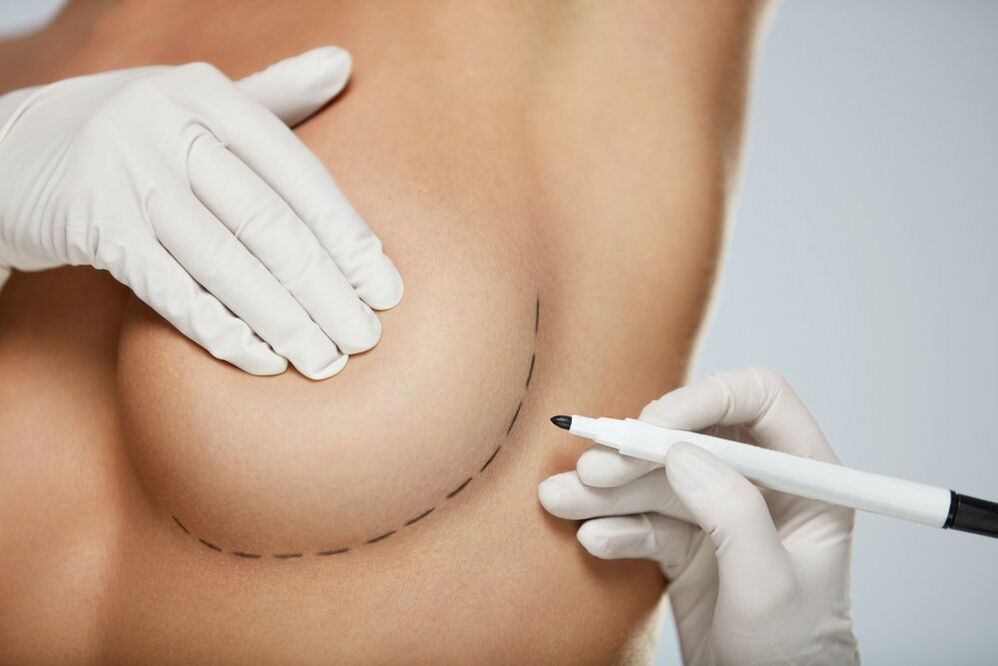Your body is your business! But if you turn to a plastic surgeon with a request to enlarge your breasts, you’re sure to ask about the reasons for the decision. And if that desire to make you look beautiful in a swimsuit, or to make your partner’s dream of big breasts come true, you’ll most likely be denied it.
Because the breast can only be enlarged for yourself, and only on the condition that you want to feel good in your body!
Honest information about breast augmentation

Breast augmentation is a serious surgery that requires an informed decision and careful calculation of potential risks. You need to be prepared for it: examine it, go through the necessary tests, stop taking certain medications in advance, lose weight if you are overweight, and quit smoking.
But even careful preparation is no guarantee of a favorable result. Therefore, before you decide to go under the scalpel of a surgeon, find out what awaits you and what can happen to you!
Images before and after are not always informative
Today, every plastic surgery clinic has its own website where you can see photos before and "after" the operations of a particular doctor. But when considering these, the patient should consider that her breasts may look different.
To get an idea of what the breasts look like after surgery, a doctor of medicine, a plastic surgeon, advises you to evaluate the results of people of similar body shape. Such recordings give a more realistic picture.
Breast augmentation is also possible without surgery
Many women are tempted to enlarge their breasts in one or two procedures without surgery. Beauticians and plastic surgeons can fulfill this desire by recommending the use of hyaluronic acid or their own fat cell-based fillers.
It should be noted, however, that these are temporary solutions. There are both pros and cons. And the outcome of the procedure is more difficult to predict than in the case of surgical breast augmentation.
Correction of shape with adipocytes has a significant disadvantage.

Not all fat cells go through "transplantation. " According to the doctor of medicine,30-50% of fat cells are killed.
However, no one knows which cells will survive and which will not. Therefore, your expectations regarding breast augmentation with fillers may not coincide with reality after the procedure.
The first breast surgery is unlikely to be the last
The implant is not a permanent purchase. According to the plastic surgeon, most need to be replaced within 12 to 15 years after surgery, and some need to be replaced even earlier.
The implant begins to leak or form scar tissue around the implant, which degrades the shape of the breast and poses a health risk. In addition, external and internal causes can push the implant to be replaced - weight gain or loss, breastfeeding, gravity.
Your doctor will only recommend planning your surgery if you are confident that your budget will allow for reconstructive surgery for the next 12 years.
Several types of incisions are made during surgery.
According to experts, depending on the initial shape of the breast and the desired parameters, the doctor may recommend surgery with an armpit, under the breast, nipple, and occasionally an abdominal incision.
The most common option is an incision in the nipple and wrinkles under the breast. The location of the probable incision should be discussed with your doctor.
Breasts cannot always be enlarged to the desired volume
If the representative of the fair sex is by nature a cup of size A, he cannot obtain the volume of DD in one operation. The skin of the breast, like the body, needs time to get used to the changes. Therefore, your doctor will first recommend a breast augmentation of 1-2 sizes, and then, if necessary, replace the implants with a larger one after a few years.
Drastic changes can be costly

"When planning breast augmentation surgery, the most important thing is to find a good implant, " says MD, a plastic surgeon. "I estimate that about 30% of the errors and complications that occur during plastic surgeries are due to the doctor or patient not choosing the right implant. "
Selecting an implant that is too large for the patient can lead to thinning of the breast tissue and surrounding muscles, which is difficult to reverse. A good doctor will always tell you the maximum implant size that the patient can be informed about.
It takes time to recover after surgery
After both breast augmentation and breast augmentation, the patient needs time to recover. The minimum sick leave will be 5-7 days. At the end of this, you can return to work, provided it does not involve hard physical work.
Painkillers can do wonders today, but don’t overestimate it!
The implants can be felt under the skin
There is an opinion that implants are always felt when they touch a woman’s breast,but this is not the case. Properly selected and well-equipped is hard to find. Nevertheless, there is such an opportunity!
Another person is more likely to suspect the presence of an implant in a woman who initially had a small breast size (and accordingly a small amount of tissue) than a woman with a larger volume.
Some implants can be harmful to health

Experts associate certain types of breast implants with an increased risk of cancer. "We’re talking about a type like anaplastic large cell lymphoma. This is thought to be related in some way to textured breast implants, as women with oncology are most often diagnosed with oncology, "the plastic surgeon warns.
The correction may affect breastfeeding ability
"By making an incision in the breast, we disrupt the natural anatomy, reducing the amount of breast tissue that produces milk, " the doctor says. they shall not be injured. "
Temporary loss of nipple sensitivity after surgery
For several weeks after surgery, many patients experience a lack of chest sensitivity, but in most cases this is a temporary phenomenon. Complete loss of perception is rare.
A doctor of medicine, a plastic surgeon, says that although he has operated on thousands of patients, he has never encountered a complete loss of female breast tenderness.
Surgery can affect a woman's posture

If a woman chooses a breast size slightly larger than her natural data, her posture is unlikely to change. But when it comes to breast implants of impressive size, their weight is perceptible and will be accordingly heavier to wear.
If there is a history of back pain, this factor should be considered.
Maybe breast augmentation alone won’t be enough
After pregnancy, childbirth and breastfeeding, some women dream of breast augmentation as a panacea that solves all the problems associated with its appearance. But it may not be enough.
Breast augmentation alone does not make the breasts tight and toned. In some cases, two surgeries are needed at the same time: breast augmentation and lifting. Your doctor may perform them at the same time.
The decision to have surgery should be balanced
Before contacting a plastic surgeon, find yourself the answers to the following questions:
- Is my current breast size really a problem for me?
- Why do I need surgery?
- Do I have an "airbag" - free funds that might be needed if something goes wrong?
- Am I ready to accept the potential risks of breast augmentation?
- Do I really need surgery?
The answers to these questions will help you make the right decision.
Expert commentary
Oncologist, general surgeonMammoplasty or breast augmentation is a type of surgical procedure that requires special preparation.
Mammoplasty is performed as part of aesthetic surgery, that is, at the request of the patient, except for breast reduction (mammoplasty) surgeries, which are often performed for health reasons. The girl should assess the risks on her own before consulting a plastic surgeon.
You must first examine the contraindications to the procedure. If a woman has severe cardiovascular pathologies, varicose veins, bleeding disorders, and oncological diseases, these chronic diseases become an absolute contraindication to mammoplasty. Such surgery is also prohibited during pregnancy and lactation.
Patients diagnosed with diabetes mellitus, hypertension, coronary heart disease, rheumatism, mastopathy, and obesity should consult their physician before breast augmentation surgery. In addition, the chronic disease should be in a stable remission phase for the duration of the procedure.
The woman should also think about her future pregnancy. If the girl plans to become a mother after the surgery, it is better to have the surgery performed under an incision under the breast or under the armpit. If implants are inserted through an incision in the nipple of the nipple, it can compromise the integrity of some of the milk ducts, which is likely to make it difficult for the baby to feed.
You need to understand that a quality procedure will not be cheap. The average cost of mammoplasty in a good clinic is quite high. Only consult with highly experienced, reliable professionals. A careful approach to selecting a doctor reduces the likelihood of postoperative complications. The meeting with the plastic surgeon usually lasts about an hour and a half. During this time, the girl should ask the doctor about the implants to determine the volume, future size and shape of the bust.
Following the consultation, a date for surgery will be set. The preparation time is about two weeks. During this time, the patient performs the tests needed to assess the health condition. The list of mandatory tests includes the following medical manipulations: clinical and biochemical blood tests, HIV tests, syphilis, hepatitis, urine tests, coagulogram, ECG, mammography, fluorography (X-ray), vascular ultrasound.
The hospital stay lasts about 3-5 days. During this time, the main operation is performed, monitoring the patient’s condition after mammoplasty and first dressing. Then the girl goes home for rehabilitation.
Wear special compression underwear for a month and do not raise your arms above your shoulders or lift heavy objects. You only need to sleep on your back for two to three weeks, in the next 4-5 months - on your side or back, you can only turn your belly over after six months. Classes in the gym as well as trips to the spa or sauna should be postponed for 2-3 months.
During the rehabilitation period, the patient should come for a bandage and seal the scars with a special silicone patch. Recovery takes about six months, after which time you can return to an active life.
Expert commentary
Plastic surgeonAll implants available in our country are covered by a lifetime warranty. This means that it will not need to be replaced over time for medical reasons.
There are three types of access: axillary, periareolar (along the edge of the nipple), and submammar (through the fold below the breast). In my practice, I most often use the armpit approach because then the scar is virtually invisible. It is located in the armpit and wrinkles over time. There are no visible scars on the chest.
I use an endoprosthesis through the nipple when access to the armpit does not allow for full-fledged surgery. I use sub-breast access for a second surgery if the implants were previously installed in the same way. All types of access are secure if owned by the surgeon.
The gel softness, sheath, type, and size of the implants vary. The surgeon can only pick them up at a personal consultation. All implants are of good quality, but usually surgeons have their own preferences. Therefore, focus on the work of the surgeon and correlate them with your own ideas about beauty.
I don’t usually use high volume implants - over 450 cc. see Large implants cause tissue atrophy and become visible over time, even when located in the armpit. That is, it is covered with muscle from above and contoured from below. This occurs in patients who are low in fiber and have a tight chest. If a woman has a wide chest, larger implants can be placed. But such cases are quite rare.
Expert commentary
Plastic surgeonAlthough mammoplasty is one of the most popular plastic surgeries and has become a fairly common procedure, before performing it, the patient needs to learn some nuances so that they are not surprised after the surgery.
- Nothing lasts forever, and implants have their own lifespan. It is impossible to install them once and for a lifetime. Sooner or later these will have to change as there is a way to depreciate. And how these processes in a particular case will take place, how the tissues will behave, no one knows in advance, any individual. Therefore, after breast correction, all girls are advised to see a mammologist at least once every six months, it is necessary to have an ultrasound examination of the breast to notice the changes in time and prescribe surgery to replace the endoprostheses.
- Patients with certain chronic conditions, and in particular those with reduced immune status, should inform their doctor, who will order further tests. And only then will you make your own judgment as to whether it is worth implanting or not.
- If the breast is ptosis, sinks down, and the main part of the mammary gland is in the lower half, it is better to install a round implant in this position. If there is no pronounced upper pole, this always means that an endoprosthesis must be inserted under the muscle.
- In the case where the nipples "look sideways" but the patient wants to bring them closer, this is only possible if there is a large amount of skin and breast tissue. If not, they cannot be brought closer, and when the implant is inserted, the nipples remain in their original position while the prosthesis is inserted into the center of the nipple.
- If the patient has a narrow interthoracic distance, he will of course remain beautiful during the installation of the endoprostheses. If large enough, more than 2-2, 5 cm, the implant can be reduced during insertion. However, it is important to take into account the fact that the implant will be palpable at this point, and over time, the appearance of a visual defect - so-called cracks or skin irregularities - cannot be ruled out.


























